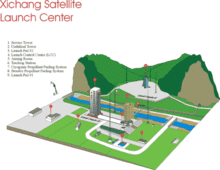
Jiuquan Satellite Launch Center is a Chinese space vehicle launch facility (spaceport) located between the Ejin, Alxa, Inner Mongolia and Hangtian Town, Jinta County, Jiuquan, Gansu Province. It is part of the Dongfeng Aerospace City. Because 95% of JSLC located in Jinta County, Jiuquan, the launch center is named after Jiuquan. The launch center straddles both sides of the Ruo Shui river.
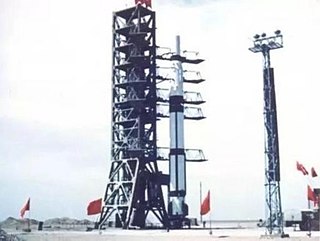
The space program of the People's Republic of China is about the activities in outer space conducted and directed by the People's Republic of China. The roots of the Chinese space program trace back to the 1950s, when, with the help of the newly allied Soviet Union, China began development of its first ballistic missile and rocket programs in response to the perceived American threats. Driven by the successes of Soviet Sputnik 1 and American Explorer 1 satellite launches in 1957 and 1958 respectively, China would launch its first satellite, Dong Fang Hong 1 in April 1970 aboard a Long March 1 rocket, making it the fifth nation to place a satellite in orbit.

The BeiDou Navigation Satellite System is a satellite-based radio navigation system owned and operated by the China National Space Administration. It is one of the global navigation satellite systems (GNSS) that provide geolocation and time information to a BDS receiver anywhere on or near the Earth where there is an unobstructed line of sight to four or more BDS satellites. It does not require the user to transmit any data, and operates independently of any telephonic or Internet reception, though these technologies can enhance the usefulness of the BDS positioning information.

The Taiyuan Satellite Launch Center (TSLC) also known as Base 25 (Chinese: 二十五基地), is a People's Republic of China space and defense launch facility (spaceport). It is situated in Kelan County, Xinzhou, Shanxi Province and is the second of four launch sites having been founded in March 1966 and coming into full operation in 1968.

The Wenchang Space Launch Site is a rocket launch site located in Wenchang on the island of Hainan, in China.
ChinaSat is the brand name of communications satellites operated by China Satellite Communications.
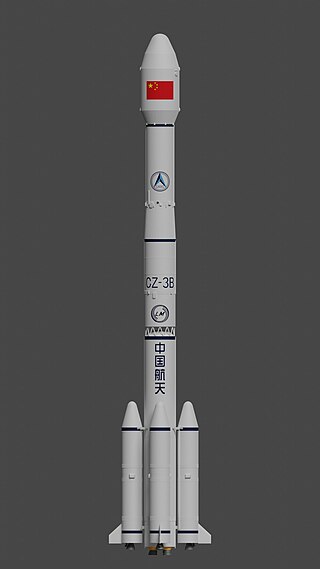
The Long March 3B, also known as the CZ-3B and LM-3B, is a Chinese orbital launch vehicle. Introduced in 1996, it is launched from Launch Area 2 and 3 at the Xichang Satellite Launch Center in Sichuan. A three-stage rocket with four strap-on liquid rocket boosters, it is the heaviest variant of the Long March 3 rocket family, and is mainly used to place communications satellites and navigation satellites into geosynchronous orbits.
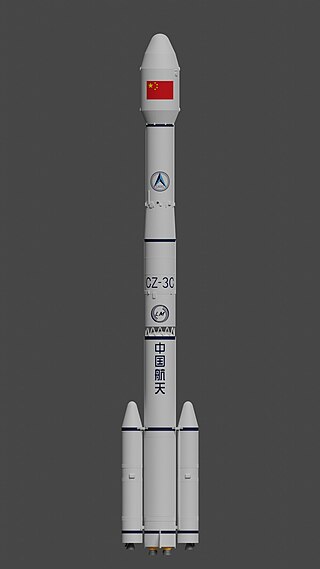
The Long March 3C, also known as the Changzheng 3C, CZ-3C and LM-3C, is a Chinese orbital launch vehicle. It is launched from Launch Complex 2 and 3 at the Xichang Satellite Launch Center (XSLC). A three-stage rocket with two strapon liquid rocket boosters, it is a member of the Long March 3 rocket family, and was derived from the Long March 3B. It was designed to fill a gap in payload capacities between the Long March 3A and 3B.
ChinaSat 9, also known as ZX-9, is a Chinese communications satellite.
Sino Satellite Communications Co., Ltd. known also as SinoSat is a Chinese company.

This article documents notable spaceflight events during the year 2019.
Ziyuan 3-01 or ZY 3-01 is a Chinese Earth observation satellite launched in January 2012. It is a high-resolution imaging satellite operated by the Ministry of Land and Resources of the People's Republic of China.

Fengyun 2-07 or FY-2-07, also known as Fengyun-2F or FY-2F, is a Chinese weather satellite operated by China's National Satellite Meteorological Centre. Part of the Fengyun programme, it was the sixth Fengyun 2 geostationary satellite to be launched.
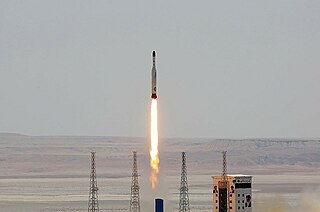
Semnan Space Center is the primary Iranian spaceport, located 50 km southeast of the city of Semnan in the north of the country.
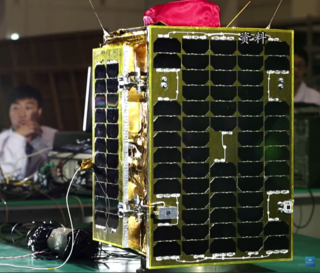
Jilin-1 is China's first self-developed commercial remote sensing satellite system. The satellites are operated by Chang Guang Satellite Technology Corporation and named after Jilin Province where the company is headquartered. The first set of satellites were launched by Long March 2D in Jiuquan Satellite Launch Center on 7 October 2015, at 04:13 UTC. All launched Jilin-1 satellites are in Sun-synchronous orbit (SSO).

Queqiao relay satellite (Chinese: 鹊桥号中继卫星; pinyin: Quèqiáo hào zhōngjì wèixīng; lit. 'Magpie Bridge relay satellite'), is the first of the pair of communications relay and radio astronomy satellites for the Chinese Lunar Exploration Program. The China National Space Administration (CNSA) launched the Queqiao relay satellite on 20 May 2018 to a halo orbit around the Earth–Moon L2 Lagrangian point Queqiao is the first ever communication relay and radio astronomy satellite at this location.
Tianlian also known as CTDRS, is a Chinese data relay communication satellite constellation. The constellation serves to relay data from ground stations to spacecraft and rockets, most significantly China's crewed spaceflight program. The system currently consists of seven satellites in two generations, with the first satellite being launched in 2008.
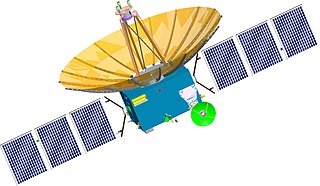
Queqiao-2 relay satellite, is a second of the two communications relay and radio astronomy satellites designed to support the fourth phase the Chinese Lunar Exploration Program. The China National Space Administration (CNSA) launched the Queqiao-2 relay satellite on 20 March 2024 to a elliptical frozen orbit around the Moon to support communications from the far side of the Moon and the Lunar south pole.



